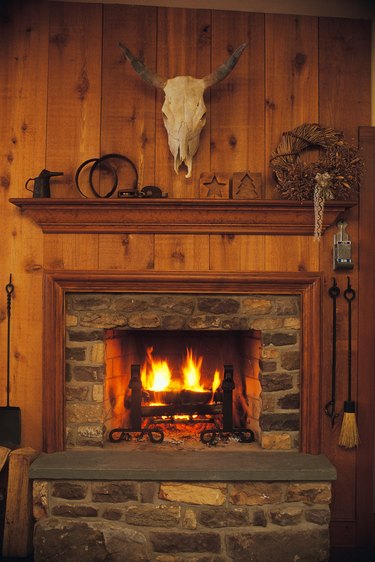Things You'll Need
Broom
Dustpan
Grout saw
Cold chisel
Hammer
Vacuum
Refractory mortar
Water
Bucket
Margin trowel
Sponge
Tuck pointing trowel

Firebricks reflect heat back into the fireplace. The repeated heating and cooling a fireplace withstands tends to weaken the firebrick and its mortar. Over time, the weakened firebrick starts to crumble and crack. Damaged firebrick allows excessive heat penetration beyond the fireplace's firebox, possibly igniting the home's wooden frame. Fireplace installers set the firebricks with a refractory mortar, a type of mortar designed for high-heat exposure. Replacing damaged firebricks reduces the likelihood of a house fire.
Step 1
Clean out the fireplace's firebox, using a broom and dust pan. Remove all of the ash and soot from the firebricks. Remove the log rack, if needed.
Video of the Day
Step 2
Cut a 3/4- to 1-inch-deep groove in the mortar around the damaged firebrick, using a grout saw. The grout saw's carbide tip grinds the soft mortar holding the damaged firebrick, but will not mar the damaged firebrick's neighbors.
Step 3
Hold a cold chisel's blade on the damaged firebrick's corner. Strike the cold chisel's handle with a hammer until the corner of the firebrick breaks off.
Step 4
Hold the cold chisel's blade in the broken corner's void. Angle the chisel's blade toward the body of the damaged brick and strike the chisel's handle with the hammer, wedging the blade between the fire brick and the cement blocks that make up the fireplace's body. Pry the damaged firebrick out of the fireplace, using the chisel for leverage.
Step 5
Remove the mortar that held the old firebrick to the fireplace, using the hammer and chisel. Discard the old firebrick and mortar debris.
Step 6
Clean the dust from the replacement firebrick's space in the fireplace, using a vacuum.
Step 7
Combine refractory mortar and water in a bucket, using the refractory mortar's manufacturer-recommended mixing ratio. Stir the mortar mixture with a margin trowel until its consistency matches toothpaste.
Step 8
Dampen the replacement firebrick's space in the fireplace, using a wet sponge. The moisture helps the mortar bond with the fireplace.
Step 9
Place a small amount of refractory mortar on the bottom of the replacement firebrick's hole in the fireplace, using the margin trowel to spread the mortar across the top of the firebricks below the replacement firebrick. Create a mortar bed twice as high as the neighboring firebrick's mortar joints.
Step 10
Butter the new firebrick's backside with a 1/8- to 1/4-inch-thick layer of refractory mortar, using the margin trowel to apply the mortar.
Step 11
Push the buttered side of the firebrick into the firebrick's space in the fireplace. Work the new firebrick until its surface rests flush with the neighboring firebricks.
Step 12
Slip the end of the margin trowel into the mortar joint above the new fire brick. Press down on the new firebrick with the margin trowel until the firebrick's bottom mortar joint matches the neighboring firebrick's mortar joints. The excess refractory mortar will squeeze out of the bottom mortar joint.
Step 13
Fill the mortar joints on the replacement firebrick's sides and top with the refractory mortar, using a tuck pointing trowel to force the mortar into the joints. Completely fill the mortar joints.
Step 14
Clean the excess refractory mortar from the firebrick's surface, using the wet sponge. Let the refractory mortar dry completely before using the fireplace.
Video of the Day